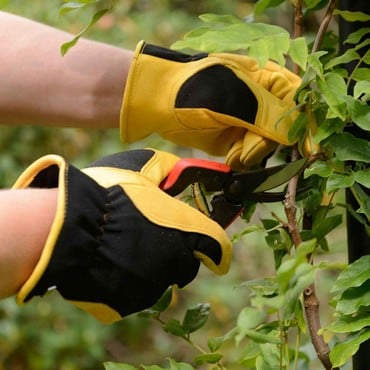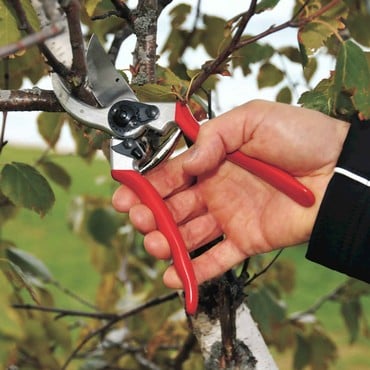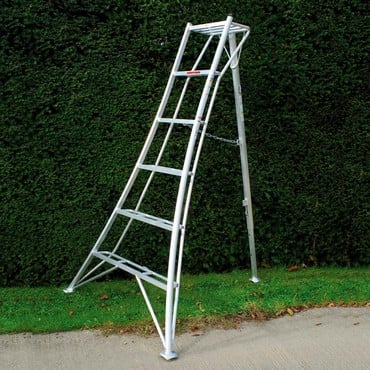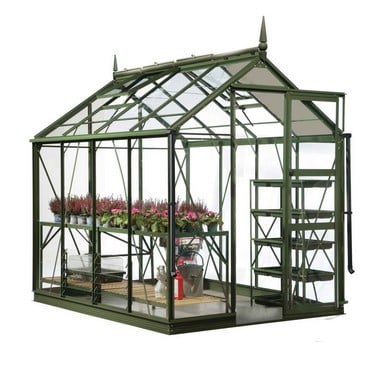
There is little gardening work that can be accomplished when it is snowing, but we had yet to prune our beautiful wisteria which should be done in February. So, we have just spent a bitterly cold day up our ladders getting the job done. Thank goodness for warm gloves! The conditions are not ideal, but when a job needs doing, it needs doing. We had plenty of tea breaks to keep us warm and the wisteria is ready for the spring; whenever it decides to arrive!
Despite the current weather, we have had a tiny taste of spring in Stephanie’s Kitchen Garden this month, with a few days of warm sunny weather. It was warm enough to leave the greenhouse door open during the day, allowing vital ventilation around the plants. The autovents on the greenhouse even nudged the windows open in the warmth of the winter sunshine. It didn’t last for long, but we enjoyed it while it lasted, taking care to replace cloches and close doors and windows before the sun disappeared again.
Inside the greenhouse it always feels like spring and our seedlings are flourishing in the heated propagator. Some, such as broccoli and brussel sprouts, have been moved onto the greenhouse staging to slowly acclimatise them to lower temperatures. As soon as the cold snap is over they will be potted into individual pots where they will grow on for a couple of weeks before being transferred to the cold frame. Our salad sowings are also growing rapidly and are now in the greenhouse raised bed. It won’t be many weeks before we are enjoying them for lunch. Slower growing crops such as aubgerines, chillies, celery and celeriac will remain the in propagator for some weeks to come.
In the last days of February we took time in the warm to make our first sowing of tomato seeds. In the past we have started them off at the beginning of February but found that they had grown too large too early when we hadn’t got the space for them. So, despite being keen for an early crop, we now sow them at the end of February and the timing of their growth suits us better. Oh! for a bigger greenhouse where we could house them along with our other greenhouse crops. I have yet to meet a gardener who is happy with the size of their greenhouse!
Early in February our seed potatoes and shallot sets arrived in the post, and we 
Last year during February we made our first sowing of parsnip seeds direct into the soil; following it up with a further sowing during March, as we have every year. This year however, with the recent extremely cold and wet weather, the soil is not warm or dry enough for us to contemplate sowing so early. We have covered the soil in some of our raised beds with fleece in an attempt to warm the soil up ready for sowing later in early March, weather permitting. Early in March we will also cover the main bed where we will be planting our early potatoes at Easter. Covering the soil will prevent saturation from the rain and being frozen solid by the cold temperatures.
The ground has literally been frozen solid for a good part of the month, which has denied us many opportunities for a good dig over of the soil. However, we have had a few good days and we made the most of them to get some digging done. We were particularly keen to get this done before the current extreme cold weather arrived, as the hard frosts will help to break down the soil that has been turned over. The icy weather will also kill off any pests that we have exposed by digging them to the surface. In the ornamental gardens, we have completed our annual mulching regime and this will keep any new shoots that have been emerging from the soil snug and safe from hard frosty weather.
Inside the fruit cage we are hoeing regularly around the base of our fruit bushes to reveal any pests to the birds that are currently enjoying access to the fruit cage. This will continue until the first signs of flowers on the strawberry plants when the roof net will be swiftly replaced. All around the garden new growth is slow to emerge this year. Snowdrops are a good month later than we would normally expect to see them in flower and the daffodils are only just beginning to peek through the soil. In the Kitchen Garden overwintering crops are surviving under their cloches and fleece covers, but showing no sign of new growth.
The cold weather has meant that house fires have been burning and providing us with plenty of ash for the garden. We have sprinkled it around the base of our fruit trees and bushes as well as around our garlic plants. This will help to add potassium to the soil and also to lower the acidity as we garden on very acidic soil. For garlic, it can help prevent rust forming later in the season.
Mother Nature is firmly in charge of the garden at the moment, limiting what we can do with the conditions she is creating. Inside the greenhouse is a different matter and it is here that we can cheat a little by creating a warm environment for our overwintering tender plants and new seedlings. It is a sanctuary that we can escape to on the darkest, coldest day and pretend that we have fast forwarded to Spring. Thank goodness for a greenhouse heater and heated propagator – every gardener should have one.
Here are some of the jobs we’ve got planned for March in Stephanie’s Kitchen Garden:
- Sow tomatoes, peppers and salads in the heated propagator.
- Dig over main beds on fine days.
- Cover the ground with fleece where potatoes are to grow.
- Plant early potatoes later in the month.
- Continue sowing and pricking out summer crops in the heated propagator.
We’re always here to offer help and support. Go to the Ask the Expert section on our website and email horticultural advisor Jo Blackwell with your queries and she’ll do her best to help.
We’re busy tweeting about all things Harrod Horticultural – what we’re doing, special offers, gardening tips and advice and you can always use Twitter or Facebook to get in touch with us as well. With our webteam manning the Tweet desks and Facebook site, you can be sure you will get the best service we can offer.
Our 108 page catalogue is out now and packed full of gardening ideas and products to solve the problems every gardener faces, plus plenty more seasonal ideas for harvesting, storage and preserving.




























